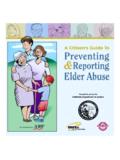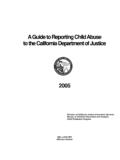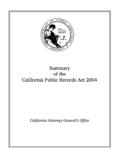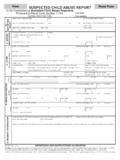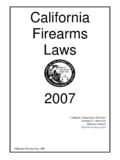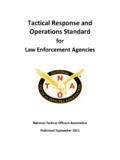Transcription of CALIFORNIA’S Megan’s Law - Department of Justice
1 california 'S. megan 's Law california Department of Justice July 2000. TABLE OF CONTENTS. PAGE. HALF A CENTURY OF SEX OFFENDER ONLY A CALL A NEW ERA OF ACCESS ..8. THE PUBLIC USES megan 'S LOOKING AHEAD ..16. FACT APPENDIX ..18. SUMMARY. Sex offenders in california have been required to register with their local law enforcement agencies for more than 50 years. However, until 1995, that information was not available to the general public. In 1994, a california law was passed which established a 900 line telephone service within the california Department of Justice to field public inquiries regarding the identity of california 's 47,000 convicted child molesters. The Department also published a subdirectory, available to the public at police and sheriff's departments, containing names and photos of 892 high-risk child molesters. The Child Molester Identification Line (CMIL), available to the public, began operation in July of 1995. In December of 1996, under california 's megan 's Law, the 900 Line was expanded to provide information to the public regarding offenders who have been convicted of specified sex crimes against adults as well as children.
2 From July 3, 1995 through December 31, 1999, the 900 Line, now known as the california Sex Offender Information, fielded a total of 56,855 inquiries. The subject of the inquiry was identified as a sex offender in 1,552 of the cases. In May 1996, President Clinton signed the federal megan 's Law, which encouraged states to register sex offenders and disseminate information regarding sex offenders to the public. Later that year, the california Legislature passed california 's megan 's Law (Assembly Bill 1562), which was signed into law by former Governor Pete Wilson in September 1996. california 's megan 's Law allows law enforcement to notify the public of serious and high-risk sex offenders who reside in, are employed in, or visits a community. california 's megan 's Law requires the california Department of Justice to produce a CD-ROM or other electronic medium containing information on serious and high-risk sex offenders. Access to the CD-ROM is mandated to be available to the public at all sheriff's departments and police departments in cities with a population of 200,000 or more as well as through the california 1.
3 Department of Justice . Many police departments with smaller jurisdictions have also voluntarily elected to make the CD-ROM available to the public. This report covers the calendar years of 1998 and 1999. Information presented in this report was gathered from responses received each year to questionnaires that were sent to law enforcement agencies that had requested the megan 's Law CD-ROM in order to make it available for the public, or to use as an investigative tool. Surveys were sent to 451 agencies regarding their use of the megan 's Law CD- ROM in 1998. Of this total, the Department of Justice received responses from 268. agencies. In 1999, the Department sent the surveys to 473 participating agencies and received responses from 307 agencies. Agencies responding to these surveys indicated that in 1998, 168 law enforcement agencies made public disclosures to their communities on 1,529 high-risk and serious sex offenders and distributed more than 43,000 fliers profiling those high-risk and serious sex offenders.
4 In 1999, 186 law enforcement agencies provided notifications to their communities on 1,613 high-risk and serious sex offenders and distributed over 74,000 fliers. Under law enforcement supervision, the megan 's Law CD-ROM was made available for public viewing by 152 law enforcement agencies during 1998 at 230 sites throughout the state. More than 26,000 people searched the CD-ROM for sex offenders by name, county, or zip code. In 1999, 162 agencies made the CD-ROM. available for public viewing at 254 locations. Nearly 30,000 people took the opportunity to obtain information on high-risk and serious sex offenders via the CD-ROM during this period. Based on surveys of people accessing the CD-ROM under the supervision of the Department of Justice at the california State Fair, Los Angeles County Fair, and the annual Governor's Conference for Women, nearly 20 percent of the viewers recognized sex offenders on the CD-ROM as individuals they knew -- friends, neighbors, employees/employers, youth coaches, and relatives.
5 Most of the time, viewers had been unaware that the identified individuals were registered sex offenders. This incident 2. rate was based on situations where viewers volunteered the fact that they recognized someone while viewing the CD-ROM. Since staff were unable to survey every viewer, it is estimated that this rate is actually much higher. Many identifications made by people accessing the CD-ROM and 900 Line resulted in actions that may have prevented the victimization of innocent children and adults. In a number of cases, information relayed to law enforcement agencies has resulted in arrests and charges filed against the offender. Other cases have resulted in a sex offender being removed from a situation in which he posed a dangerous risk, such as a child molester who was allowed to baby-sit or otherwise supervise children. Of course, megan 's Law can only be successful in jurisdictions where it is made available and used. During the last two years, more than 60 percent of the law enforcement agencies responding to the survey had policies that allowed notifications to the public on high-risk or serious sex offenders under specified conditions.
6 During this same period, more than 50 percent of those law enforcement agencies allowed the public to access the CD-ROM. Though some smaller police departments are located within a short distance of the sheriff's Department where the CD-ROM is available for public viewing, in many cases the public has to travel some distance in order to access the CD-ROM. Viewership can be expanded by agencies alerting the public to the availability of the CD-ROM at their agency, ensuring that the CD-ROM is available during hours that the public finds convenient ( evening or weekend hours), or making the CD-ROM available at multiple locations throughout a jurisdiction or at public events. Nearly 20 percent of the agencies make the CD-ROM available at multiple locations. In 1998, 34 agencies made the CD-ROM available at community events such as county fairs, Parent Teacher Association meetings, neighborhood watch meetings and family safety fairs. During 1999, the number of agencies conducting this type of community outreach rose to 45.
7 This has been a highly effective way of reaching the public. A Fresno Bee editorial (November 27, 1999) pointed out Though police sometimes distribute fliers informing neighborhoods about convicted sex offenders living nearby, viewing 3. the megan 's Law file (CD-ROM) is the best way for citizens to protect themselves.. Opponents of california 's megan 's Law feared that dissemination of this information would result in widespread vigilante actions aimed at sex offenders. However, since the implementation of california 's megan 's Law, there have only been two minor vigilante acts against sex offenders resulting from megan 's Law disclosures reported to the Department of Justice by law enforcement . After more than three years, the purpose of california 's megan 's Law remains the same -- to provide the public with information that will allow them to protect themselves and their families from convicted sex offenders. 4. HALF A CENTURY OF SEX. OFFENDER REGISTRATION. california 's sex offender registration program was enacted in 1947.
8 This law was the first in the nation to require convicted sex offenders to notify local law enforcement agencies of their whereabouts. As of December 1999, there are more than 86,000 sex offenders who are required to register in california . Sex offenders are required to register within five working days after release from a local jail or state prison, completion of any alternative sentence, and re-register when they change their name or address. In addition, each sex offender is required to re-register annually within five working days of their birthday. Sex offenders convicted in federal or military courts or in other states for certain sex offenses are also required to register within five days of entering california . Since 1995, sex offenders convicted of felonies who fail to register can be charged with a felony. With the implementation of megan 's Law in 1996, a convicted, registered sex offender is classified as a high-risk sex offender, as defined by Penal Code Section 290(n); or as a serious sex offender, as defined by Penal Code Section (a)(1); or as an other sex offender.
9 As of December 1999, nearly 73,000 sex offenders were classified as high-risk or serious, allowing for public disclosure of specific information by law enforcement officers, or through the megan 's Law CD-ROM or the 900 telephone line service. The remaining 13,000 registered sex offenders are classified as other and not subject to public disclosure since their offenses do not meet the criteria set forth in california 's megan 's Law. 5. ONLY A CALL AWAY. On July 3, 1995, california started the Child Molester Identification Line, the first program of its kind in the nation. This telephone service, using a fee-based 900 . line, provided information to adults regarding convicted child molesters. In December 1996, due to the passage of megan 's Law, the information available through the 900 Line was expanded to include most sex offenders that committed crimes against adult victims. The name was changed to the Sex Offender Identification Line to reflect the availability of the expanded information.
10 Effective July 2000, the Department adapted the name california Sex Offender Information. Adults wishing to inquire about an individual are able to call the 900 Line service at a cost of $10 per call for inquiries on up to two individuals. Callers to the line must be 18 years of age or older. To complete a search, the caller must provide the individual's name, and at least one of the following: exact date of birth, exact street address, social security number, california driver's license or california identification number. If that information is not available, the caller must provide the individual's name and be able to describe five of the following characteristics: eye color, hair color, height, weight, race/ethnicity, or scars, marks or tattoos. The information provided is used by Department of Justice employees to search the 900 . Line database. A hit occurs when information provided by the caller matches information about an individual listed in the database. The caller is then informed that the person upon whom they inquired is either a high-risk or serious sex offender.
